AN/APS-20
The AN/APS-20 was an airborne early warning, anti-submarine, maritime surveillance and weather radar developed in the United States in the 1940s. Entering service in 1945, it served for nearly half century, finally being retired in 1991. Initially developed at MIT under Project Cadillac, the radar was developed to be carried by aircraft to extend the sensor range of ships by placing a radar at altitude. Although developed for carrier-borne operation, first being installed in the single-engined General Motors TBM-3W Avenger, it was also used in larger four-engined airframes, the last carrier being a fleet of Avro Shackleton AEW.2 converted maritime partrol aircraft. Similarly, although developed for detecting aircraft, it saw extensive service in anti-submarine and maritime patrol roles and was one of the first radars to be used in researching extreme weather like hurricanes by agencies like the ESSA. As well as the United States, the radar was used by a large number of services in other countries, including the French Navy, JMSDF, RAF and RCAF. Early versions of the radar could see a low flying aircraft at 65 nautical miles (120 km; 75 mi) and a ship at 200 nautical miles (370 km; 230 mi). This was improved, so that later versions had a range against aerial targets of 115 nautical miles (213 km; 132 mi).
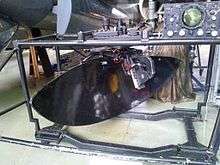 AN/APS-20 at the Museum of Science and Industry in Manchester | |
| Country of origin | United States |
|---|---|
| Manufacturer | General Electric Hazeltine |
| Introduced | 1945 |
| Type | Airborne early warning, maritime patrol, weather research |
| Frequency | S Band (APS/AN-20A), plus L and X Band (AN/APS-20E) |
| PRF | 500 MHz |
| Beamwidth | 1.5° (horizontal), 6° (vertical) |
| Pulsewidth | 2 μs |
| RPM | 3 or 6 |
| Range | 200 nmi (370 km; 230 mi) against surface ships, 65 nmi (120 km; 75 mi) (APS/AN-20A) |
| Diameter | 8 ft (2.4 m) (APS/AN-20A) |
| Power | 1 MW (APS/AN-20A) |
Background
From the early days of its development, radar had been used to detect aircraft. Early apparatus was large and required substantial power, and so was limited to fixed locations. However, during World War II, increasingly smaller radar set were installed in vehicles, like aircraft.[1] As aerial attacks by the Imperial Japanese Navy against its warships became more prevalent and protecting these ships became more dependent on aircraft carriers and their squadrons, the United States Navy became aware of the need to have airborne radar to identify attacking aircraft beyond the range of shipborne radar.[2] Radars optimised for night fighting, which were typically installed onboard aircraft, proved inadequate for the task.[3]
Design and development

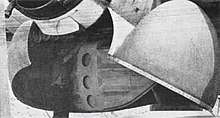
The solution to the problem of detecting objects beyond the horizon lay in developing a dedicated airborne early warning radar. On 2 February 1942, the US Navy commissioned the Radiation Laboratory at the Massachusetts Institute of Technology to explore an airborne radar design dedicated to seeking aircraft under Project Cadillac, named after the Cadillac Mountain in Maine.[4] The team grew rapidly from thirty seven, including ten officers in May 1943 to one hundred thirty eight at the end of the War. The outcome of the development was an S-Band radar designated AN/APS-20.[3] Development continued in two guises. Cadillac I, the initial platform, was to be carrier-based and the first radar was fitted to a converted General Motors TBM-3 Avenger.[6] Simultaneously, the need for a land-based version was recognised. Under the guise of Cadillac II, a single Boeing B-17G Flying Fortress was fitted with the radar.[7]
The production radar was manufactured by General Electric and Hazeltine.[8] The first version, the AN/APS-20A, had, initially, an 8 ft 4 in (2.54 m) antenna and operated on a frequency of 2850 MHz in the S band.[3] Later a slightly smaller 8 ft (2.4 m) antenna was used.[8] The scanner was two speed, 3 rpm and 6 rpm. The radar worked at a PRF of 300 Hz, a pulse length of 2 μm (7.9×10−5 in). Peak power was 1 MW (1,300 hp).[9] The AN/APS-20B, designed to be carried by larger aircraft, differed in having limited fighter direction capability. It had a peak power of 2 MW (2,700 hp) and a horizontal beam width of 1.5° and vertical 6°. Pulse width was 2 μs.[10] Range was extended to 65 nautical miles (120 km; 75 mi) against low flying aircraft and 200 nautical miles (370 km; 230 mi) against shipping.[11] Later versions expanded the capability. The AN/APS-20F extended the range against aircraft to 80 nautical miles (150 km; 92 mi), while the larger AN/APS-20E could detect an aerial 1 m2 (11 sq ft) target at 115 nautical miles (213 km; 132 mi).[12]
Service
Trials
The first aircraft equipped with the radar was a converted General Motors TBM-3 Avenger, designated XTBM-3W, which first flew on 5 August 1944. The radar was mounted in a radome under the forward fuselage. A series of aircraft were converted from existing TBM-3 airframes by the Naval Aircraft Modification Unit and designated TBM-3W, with initial training aboard the aircraft carrier Ranger starting in May 1945.[13] At the same time, thirty one large Boeing PB-1W aircraft were converted from B-17G bombers to become the first land-based aircraft equipped with the radar. They were especially designed to combat the increasing threat of Japanese suicide attacks.[7] The crew of the Avenger consisted of, as well as the pilot, a single Radar Operator (RO). The larger size of the PB-1W allowed for two Radar Operators, a Electronics Technician and, critically, a Combat Information Center (CIC) Officer supported by two radio operators. The latter team was able to direct aircraft to the target, adding the ability of the aircraft to control fighters and enabling operation independent of shipboard or ground-based control. This capability was later developed into the Airborne Warning and Control System (AWACS). The War ended before either aircraft became operational.[14]
Operational use
Post-war, the Navy quickly accelerated a program to get the radar into operational use. The AN/APS-20 was installed in the Douglas AD3-W Skyraider, which replaced the Avenger, and the Lockheed PO-2W Warning Star.[15] Both also saw service outside the US Navy. The latter, which could carry up to 32 servicemen for long trips, so impressed the newly formed USAF that it ordered it into service as the Lockheed EC-121 Warning Star. Following a test between 24 February and 23 March 1953, the USAF used their aircraft to mount a near-continuous monitor of potential incursion by the Soviet Air Forces of American continental airspace.[16] At the same time, the Royal Navy procured fifty examples of the AD3-W as the Skyraider AEW.1.[17] In an attempt to extend endurance, in 1954 the US Navy ordered the installation of the radar in a blimp, the ZP2N-1W, later redesigned ZPG-2W and then, in 1962, EZ-1B. This was superseded by the even larger ZPG-3W.[18]
Expanding capabilities
Alongside these developments, new uses of the radar were explored. One arena where the radar broke new ground was in weather research, particularly with the hurricane hunters that flew into tropical storms. The first trials of the radar took place in 1946 with a PB-1W and in 1955 the US Navy redesignated squadron AEW-4, which was equiiped with the radar, to VW-4 to recognise its change in emphasis from simply Airborne Early Warning to include Weather Reconnaissance.[19] The aircraft frequently flew up to three times a week on tropical cyclone observation, and also supported the early American space programme, including tracking for Project Mercury.[20] At the same time, VW-1 was providing a similar service tracking typhoons in the Pacific. Other users of the radar included the Environmental Science Services Administration and its successor the National Oceanic and Atmospheric Administration.[22] Aircraft operated by these agencies were also made available to universities, and therefore the radar was also used as a tool for academic research where its attributes proved invaluable in the study of precipitation.[23] It was used in a wide range of airframes, including converted Douglas DC-6 airliners and the dedicated Lockheed WP-3A Orion which served into the 1970s.[24][25]
_APS-20E_radome_right_front_view_at_Kanoya_Naval_Air_Base_Museum_April_29%2C_2017.jpg)
Meanwhile, in 1948, the UK evaluated a PB-1W equipped with AN/APS-20 against a Vickers Warwick V fitted with ASV.13 to see if the radar could also be used to identify surface ships, but the peak power was deemed too high and the pulse length too long for the application.[9] Nonetheless, the Royal Canadian Air Force used the radar in their maritime surveillance Canadair Argus Mk.1.[26] Of greater impact, however, was the improved AN/APS-20E subsequently used in the role in the Lockheed P2V Neptune. The radar first flew in the third airframe, designated P2V-2S, which was the first developed for the anti-submarine role.[27] Initially deployed in 1953, the radar operated in the L band, S band and X band, with a wide selection of PRFs and pulse widths in each band. It also included automatic target indication, three choices of heading reference and stabilization, selectable azimuth and elevation beam widths, selectable output and receiver radiated gain and automatic gain control amongst other features.[28] The radar proved effective at identifying large surface ships up to 200 nautical miles (370 km; 230 mi) away but was ineffectual when tracking periscopes.[29]
The USAF started to replace the radar in the 1950s, but it continued to serve in aircraft operated by forces across the world. The United States Navy replaced the radar with the AN/APS-80 in the anti-submarine role, which offered similar capabilities but added continuous 360° area search coverage.[29] The Canadians finally replaced their AN/APS-20 with AN/APS-115 in 1981.[30] The last operator of the radar was the Royal Air Force. When the Royal Navy retired their last AN/APS-20, they were refurbished and fitted to retiring Avro Shackleton MR.2 maritime patrol aircraft. Re-entering service in 1972, the aircraft continued to operate until July 1991.[31]
Variants
- AN/APS-20A
- Initial version developed for carrier-based aircraft with single 12 in (300 mm) CRT display.[9]
- AN/APS-20B
- Initial version developed for land-based aircraft with additional command and control capability.[11]
- AN/APS-20C
- Improved version to equip both large four-engine and carrier-borne single-engine aircraft.[32].
- AN/APS-20E
- Larger antenna version optimised for maritime patrol.[33]
- AN/APS-20F
- Version with smaller antenna and less range than AN/APS-20E.[12]
Applications
Aircraft
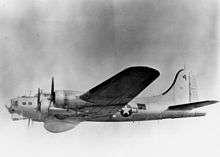
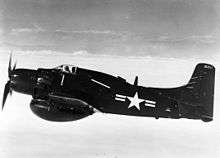

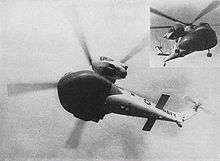
- Avro Shackleton AEW.2 – 12 converted.[17]
- Boeing B-29 Superfortress – 3 converted.[32]
- Boeing PB-1W – 32 converted.[14]
- Canadair Argus Mk.1 – 13 built.[26]
- Fairey Gannet AEW.3 – 44 built.[34]
- Douglas AD-W / EA-1 Skyraider – 367 built, including one XAD-1W prototype.[15]
- Douglas Skyraider AEW.1 – 50 built.[17]
- Douglas DC-6 – 2 converted.[24]
- Goodyear ZPG-2W – 5 built.[18]
- Goodyear ZPG-3W – 4 built.[18]
- General Motors TBM-3W Avenger – 27 converted.[13]
- Grumman Avenger Mk.3W2 – 8 delivered.[35]
- Grumman TB3F-1S / AF-2W Guardian – 156 built, including one XTB3F-1S prototype.[15]
- Lockheed PO-2W / WV-2 / EC-121 Warning Star. 232 built.[15]
- Lockheed P2V-3W Neptune – 30 built.[36]
- Lockheed P2V-4 / P-2D Neptune – 51 built, including P2V-2S prototype.[33]
- Lockheed P2V-5 / P-2E Neptune – 424 built.[33]
- Lockheed P2V-7 / P-2H Neptune – 287 built, including 48 assembled by Kawasaki.[33]
- Lockheed EP-3E Orion – 2 converted.[37]
- Lockheed WP-3A Orion – 4 converted.[25]
- Sikorsky HR2S-1W – 2 built.[38]
References
Citiations
- Friedman 1985, p. 95.
- Hirst 1983, p. 58.
- Norton 2008, p. 213.
- Hirst 1983, p. 59.
- Friedman 1985, p. 146.
- Hirst 1983, p. 60.
- Streetly 1984, p. 58.
- Watts 2018, p. 8-7.
- De la Moriniere 1972, p. 210.
- Streetly 1984, p. 36.
- Friedman 1985, p. 253.
- Norton 2008, p. 214.
- Hirst 1983, p. 61.
- Hirst 1983, p. 64.
- Grier 2005, p. 78.
- Hirst 1983, p. 66.
- Hirst 1983, p. 72.
- Reade 2011.
- Hunt 1963, p. 14.
- Polmar 1997, p. 537.
- Senn & Courtright 1969, p. 25.
- De la Moriniere 1972, p. 177.
- Fine 1976, p. 1.
- Chant 1980, p. 34.
- Francillon 1987, p. 264.
- Shannon 2014, p. 212.
- Shannon 2014, p. 213.
- Francillon 1987, p. 413.
- Tyack 2005, p. 87.
- Lloyd 1987, p. 63.
- Chant 1980, p. 62.
- Chant 1980, p. 191.
- Skaarup 2001, p. 41.
- Francillon 1987, p. 265.
- Polmar 1997, p. 379.
- Gunston 1977, p. 59.
- Chant 1980, p. 17.
- Chant 1980, p. 19.
- Chant 1980, p. 28.
- Chant 1980, p. 92.
- Chant 1980, p. 113.
- Chant 1980, p. 126.
- Senn & Courtright 1969, p. 24.
- Hirst 1983, p. 65.
Bibliography
| Wikimedia Commons has media related to APS-20 radar. |
- Chant, Christopher (1980). The World's Air Forces. Newton Abbot: David & Charles. ISBN 978-0-71537-690-4.
- De la Moriniere, Terry (1972). BOMEX Temporary Archive Description of Available Data (Report). Washington: NOAA. Retrieved 11 June 2020.
- Fine, Frederick (1976). VHF-UHF Aircraft Antenna (Report). 8012. Washington DC: Naval Research Laboratory.
- Francillon, René J. (1987). Lockheed aircraft since 1913. London: Putnam. ISBN 978-0-85177-805-1.
- Friedman, Norman (1985). U.S. Naval Weapons: Every Gun, Missile, Mine, and Torpedo Used by the U.S. Navy from 1883 to the Present Day. Annapolis: Naval Institute Press. ISBN 978-0-87021-735-7.
- Grier, Paul (April 2005). "The Fall of the Warning Stars". Air Force Magazine. 88: 78–79.
- Gunston, Bill (1977). Helicopters at War. London: Chartwell Books. ISBN 978-0-70260-020-3.
- Hirst, Mike (1983). Airborne Early Warning: Design, Development, and Operations. London: Osprey. ISBN 978-0-85045-532-8.
- Hunt, Jack (April 1963). "They Hunt the Hurricanes". Naval Aviation News: 14–17.
- Lloyd, Alwyn T. (1987). B-29 Superfortress in Detail & Scale. Blue Ridge Summit: Tab Books. ISBN 978-0-83068-035-1.
- "Navymen Go Where the Wild Winds Blow". Naval Aviation News: 14–17. January 1955.CS1 maint: date and year (link)
- Norton, William (2008). U.S. Experimental & Prototype Aircraft Projects. North Branch: Specialty Press. ISBN 978-1-58007-109-3.
- Polmar, Norman (1997). Naval Institute Guide to the Ships and Aircraft of the U.S. Fleet. Annapolis: Naval Institute. ISBN 978-1-55750-686-3.
- "Project Cast: Radar Learns to Fly". Naval Aviation News: 1–4. April 1946. Retrieved 11 June 2020.CS1 maint: date and year (link)
- Reade, David (15 December 2011). "Storm Hunters: The Navy's Hurricane Reconnaissance Units". Naval Aviation News. Retrieved 11 June 2020.CS1 maint: date and year (link)
- Senn, Harry V.; Courtright, Charles L. (1969). Radar Hurricane Research 1 September 1968 to 31 August 1969 (PDF) (Report). Miami: Rosenstiel School of Marine and Atmospheric Sciences, University of Miami. Retrieved 11 June 2020.
- Shannon, John G. (January 2014). "A History of U.S. Navy Airborne and Shipboard Periscope Detection Radar Design and Development". U.S. Navy Journal of Underwater Acoustics: 203–231.CS1 maint: date and year (link)
- Skaarup, Harold A. (2001). Canadian Warbirds of the Post-War Piston Era. San Jose: Writers Club Press. ISBN 978-0-59518-420-0.
- Streetly, Martin (1984). World Electronic Warfare Aircraft. London: Jane's. ISBN 978-0-71060-166-7.
- Tyack, Bill (2005). "Maritime Patrol in the Piston Engine Era" (PDF). Royal Air Force Historical Society Journal (33): 67–89. ISSN 1361-4231. Retrieved 11 June 2020.
- Watts, Simon (2018). Airborne Maritime Surveillance Radar: Volume 2, Post-war British ASV Radars 1946-2000. San Rafael: Morgan & Claypool. ISBN 978-1-64327-073-9.